An overview of what you need to know about Afternoon Tea. Afternoon Tea is arguably the best contribution the British have made to cuisine. A lovely tradition My book Relaxing Over Afternoon Tea has everything you need to know about this ritual, whether you are planning to visit a famous tea house in London, organizing a fundraiser or just hosting a tea at home.
This article provides highlights on history, what to eat, how to eat, and when to eat! Enjoy. If you like the post, consider buying my book, available for download on my site or in hard copy from Amazon.
Relaxing Over Afternoon Tea
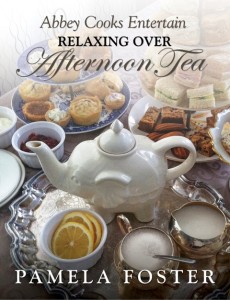
History of the English Tea Ritual
In 1662 Catherine of Braganza of Portugal married Charles II and brought with her the preference for tea, which had already become common in Europe. As tea was her temperance drink of choice, it slowly gained social acceptance among some of the aristocracy as she replaced wine, ale and spirits with tea as the court drink. It did take some time though to ween courtiers from enjoying ale at breakfast. Baby steps.
Origins of Afternoon Tea
The actual taking of tea in the afternoon developed into a new social event some time in the late 1830’s and early 1840’s. It was Anne, Duchess of Bedford, one of Queen Victoria’s ladies-in-waiting, who is credited for first “inventing” Afternoon Tea, but actually it had been a gradual evolution. The gap between lunch and supper was widening, so Anne started asking for tea and small cakes to be brought to her private quarters. I am sure she quickly realized that a lot of gossip could be shared if she invited other ladies to her quarters to share her cakes. Queen Victoria herself was encouraged to start hosting parties as a way of re-entering society after the passing of her beloved husband Albert. Legend has it that Victoria Sponge was named and served at her tea parties which became large affairs. Other women picked up the idea, and spread like wildfire. Thus the ritual of afternoon tea began. Women do know how to get things done.
Tea Lingo: Afternoon Tea is Not High Tea
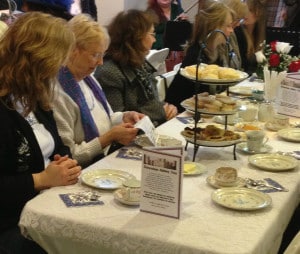
There is nothing like enjoying tea with friends or colleagues. Check out my recent tv interview about hosting a tea party. If you are planning a visit to the UK, watch Downton Abbey, Coronation Street, or other British-type serials, it might be helpful to get proper knowledge of the terms used.
- Afternoon Tea — What we imagine all British teas to be. An afternoon meal, served typically from 4 – 6 pm, includes the tiers of smart little crustless sandwiches, scones, clotted cream, curd, 2-3 sweets and heaps of tea.
- High Tea or Tea — High tea is eaten in “high chairs” at the dinner table. Afternoon Tea is traditionally served on lower couches and lounging chairs. High tea is actually is a meal that the working class had at the end of the day with cold meats, potatoes, as well as other foods with tea and perhaps a beer. Americans confuse the two, and since some London tea houses use the terms interchangeably to keep tourists happy, it adds to the confusion.
- Low Tea— This is still afternoon tea but called “low tea” because guests are seated in low armchairs with low side tables on which to place their cups and saucers.
- Royale Tea — A social tea served with champagne at the beginning or sherry at the end of the tea.
- Celebration Tea — Another variation of afternoon tea with a celebratory cake which is also served alongside the other sweets
- Cream Tea — A simple tea service consisting of scones, clotted cream, marmalade or lemon curd and tea.
- Elevensies—Morning coffee hour in England (I remember the Hobbits using this term in Lord of the Rings. I thought they ate 11 times a day…just like me!).
Tea Etiquette: Learn by Example from Downton Abbey
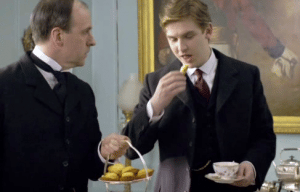
Displaying acceptable manners is a way of fitting in with a certain class, and it starts with what to wear to this afternoon tea time. If you recall the “tea scene” in S1 E2 of Downton Abbey, the new heir, Matthew Crawley, comes home to find visitors and decides to help himself to tea and madeleines. Molesley, the butler, is horrified, and his mother, the Dowager and Cora are embarrassed. Yes, it is evident that this middle-class lawyer is a diamond in the rough and has a long way to go before becoming a true gentleman, but we gradually see him growing into the role of heir apparent. If you plan to enjoy the tea ritual in London or your hometown, book an Afternoon Tea (not High Tea), and take note of proper manners to enjoy the experience fully. In London, they try to do things properly, which is why we adore Downton Abbey in the first place, right?
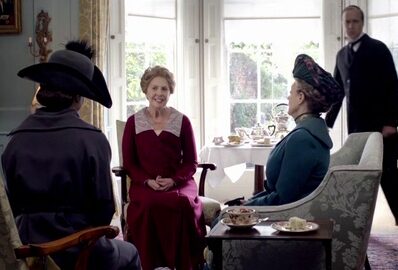
Tea with the Dowager could be stressful since there was always some plan she had in mind to discuss. To help make your tea experience less stressful, here are some tips to take to the Dowager House, your local tea shop, or a famous London tea house:
- Sugar/lemon —tea is poured first, then sugar or thinly sliced lemon and never milk and lemon together as it will curdle.
- Milk goes in after tea — a nice little saying: “To put milk in your tea before sugar is to cross the path of love, perhaps never to marry.” (Tea superstition)
- Who Pours? — If you are the hostess, you should pour. If you are taking tea at a tea house, it is the person closest to the pot when the pot is brought to the table.
- Proper placement of the spoon — the spoon never stays in the cup.
- Proper holding of cup — use both hands to lift both cup and saucer to drink from, and please no pinkies*. I dare you to catch anyone on Downton
- When eating on a tea tray, the correct order is to eat savouries first, scones next, and sweets last.
- Scones—According to Debrett, the most practical approach is to split the scone horizontally before adding your favourite spreads.
- Cream, then jam on scones? —This depends. Devon tradition puts clotted cream first on scones, then jam. In Cornwall, preserves first. Eat with fingers neatly.
- Use your fingers—you can eat bite-size pastries with your fingers, as well as sliced loaves, breaking off small pieces before consuming. Use a dessert fork to eat larger pastries.
- No dunk zone. Unless your tea party is very informal, dunking treats in your tea will garner a scowl.
*Since ancient Rome, a cultured person ate with three fingers, a commoner with five. Thus, the birth of the raised pinkie was a perceived sign of elitism. However, the pinky “up” rule misinterprets the three-finger vs. five-finger dining etiquette. You will never see the ladies at Downton Abbey raise a pinky.
Build a Tea Service on a Budget
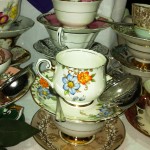
I am a bit of a packrat and have accumulated several pieces over the years for my tea service. Some I have inherited, some treasured gifts from friends, but many I have picked up at yard sales and thrift stores over the years. Your tea service does not have to match, and in fact, it works out better when each person has their cup to keep track of.
If you want to start your tea service, try checking out your local Goodwill store. You will be amazed at what you may find.
[youtube http://www.youtube.com/watch?v=lpjZU48if3I]
How to Make Tea
Don’t get too stressed about making tea, mainly since much is now sold in tea bags. To distinguish yourself as a tea aficionado, however, just follow the time-honoured tradition of first warming the teapot. Add a bit of boiling water to the pot, give it a swirl and pour it out before adding your tea. Steep for 3 or 4 minutes, and don’t let the tea steep too long, or it will become bitter. If you go with loose tea, the general guideline is to allow for 1 tsp per person, 1 tsp for the pot, and 10 ounces per person. Use a tea strainer and pour into cups. You may wish to fill your teapot with tap water, and pour it into a measuring cup to determine how many cups your pot will hold. Debrett’s also advises that you keep a heated pot of water nearby to help dilute the tea if it is too strong.
Let’s Eat: The Tea Menu
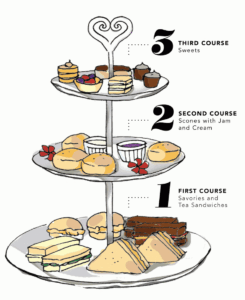 The following are the types of items you will find at tea. Follow the links to locate recipes for items we have prepared in our travels. Essentially the tray holds the 3 S’s: Sandwiches/Savouries, Scones, and Sweets. I mostly focus on traditional tea items (great food always has a history). I am a big fan of healthy eating, and while many of these treats are “sometimes” foods, I also include healthy versions of some treats which you can enjoy anytime.
The following are the types of items you will find at tea. Follow the links to locate recipes for items we have prepared in our travels. Essentially the tray holds the 3 S’s: Sandwiches/Savouries, Scones, and Sweets. I mostly focus on traditional tea items (great food always has a history). I am a big fan of healthy eating, and while many of these treats are “sometimes” foods, I also include healthy versions of some treats which you can enjoy anytime.
The general rule to the tea tray is that items can be eaten by hand, so are cut into bite-sized pieces (cut cakes into small pieces for example), and generally cold, unless you have scones right out of the oven.
Afternoon Tea Menu
Traditionally tea trays have three layers. Though it appears you eat from the top down, you eat from the bottom up, typically since sandwiches are larger than sweets.

